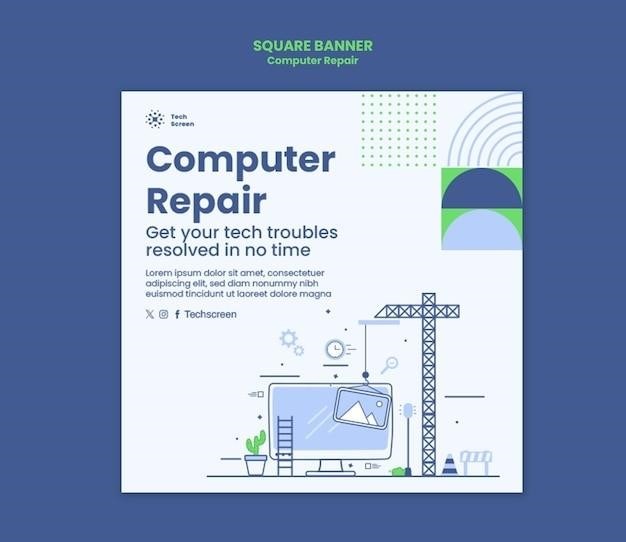uts motor series filetype:pdf
UTS Motor Series Overview
UTS motor series documentation‚ including specifications‚ is available as PDF datasheets. These files detail various motor types like UTS-19-A-30 and UTS-41-A.
UTS motors represent a cutting-edge solution in direct drive technology‚ offering exceptional performance for precision motion control applications. These motor series‚ detailed in available PDF datasheets‚ are characterized by their slotless magnetic design and ability to deliver zero cogging with remarkably low torque ripple. This results in incredibly smooth velocity control and minimized vibration‚ crucial for sensitive operations.
The UTS range encompasses various models – UTS-19-A-30‚ UTS-29-A-21‚ UTS-29-A-51‚ and UTS-41-A – each designed for specific needs. They are frequently integrated into motorized linear stages‚ providing travel ranges from 50 to 150mm‚ and are available in both CC (DC motor) and PP (Stepper motor) configurations. These motors are engineered for reliability and precision.
Historical Development of the UTS Motor Series
While specific detailed historical documentation isn’t readily available in the provided snippets‚ the UTS motor series clearly represents a progression towards advanced direct drive technology. The evolution focuses on minimizing friction and maximizing smoothness‚ evidenced by the slotless magnetic design and zero-cogging characteristics detailed in associated PDF specifications.
The series’ development likely stemmed from a need for higher precision and reduced vibration in applications like motorized linear stages. The availability of diverse models – UTS-19-A-30 through UTS-41-A – suggests iterative improvements and broadening of application scope. The emphasis on features like low torque ripple points to a commitment to refined motion control performance over time.
Key Features of UTS Motors
UTS motors distinguish themselves through several core features‚ prominently highlighted in their technical specifications (available in PDF format). These include zero cogging‚ resulting in exceptionally smooth velocity control and minimal vibration. The innovative slotless magnetic design‚ coupled with direct drive technology‚ enables highly precise and efficient operation.
Furthermore‚ the series offers versatility with options for both DC (CC) and stepper (PP) motor types‚ catering to diverse application requirements. Pressure ratings up to 16 bar at 20°C (for UTS 200/250 series) demonstrate robust construction. Standardized flange connections (UNI 1092-1) and mounting configurations (UTS evo B5 frame) simplify integration.

UTS Motor Series Specifications
Detailed specifications for UTS motors – including UTS-19-A-30‚ UTS-29-A-21‚ and UTS-29-A-51 – are comprehensively documented in available PDF datasheets.
UTS-19-A-30 Motor Specifications
The UTS-19-A-30 motor‚ as detailed in associated PDF documentation‚ represents a core component within the broader UTS motor series. While specific numerical values require direct datasheet consultation‚ the documentation confirms its inclusion in the series alongside models like UTS-29-A-21 and UTS-29-A-51.
These files outline critical parameters essential for integration into motorized linear stages‚ offering travel ranges between 50-150mm. The UTS-19-A-30 supports both CC (DC motor) and PP (Stepper motor) configurations‚ exemplified by the UTS50CC stage utilizing a 50mm travel range. Further details regarding rotor dimensions (length‚ OD‚ ID)‚ winding OD‚ and stator specifications (OD‚ ID) are accessible within the PDF resources.
UTS-29-A-21 Motor Specifications
PDF datasheets for the UTS-29-A-21 motor confirm its position within the UTS motor series‚ alongside counterparts like the UTS-19-A-30 and UTS-29-A-51. These documents are crucial for understanding its integration into applications such as motorized linear stages‚ offering travel ranges spanning 50-150mm.
The UTS-29-A-21 is compatible with both CC (DC motor) and PP (Stepper motor) drive types‚ as demonstrated by the UTS50CC example. Detailed specifications regarding rotor dimensions – length‚ outer diameter (OD)‚ and inner diameter (ID) – alongside winding OD and stator dimensions (OD‚ ID) are comprehensively outlined within the downloadable PDF files. These specifications are subject to change.
UTS-29-A-51 Motor Specifications
Detailed UTS-29-A-51 motor specifications are readily available in PDF datasheet format‚ aligning with the broader UTS motor series documentation – including models UTS-19-A-30 and UTS-29-A-21. These resources are essential for engineers integrating the motor into applications like motorized linear stages‚ offering travel ranges from 50 to 150mm.
The PDF outlines compatibility with both CC (DC motor) and PP (Stepper motor) configurations‚ exemplified by the UTS50CC model. Crucially‚ the datasheets specify rotor dimensions (length‚ OD‚ ID)‚ winding OD‚ and stator dimensions (OD‚ ID). Note that these specifications are subject to change‚ so always refer to the latest PDF version for accurate data;

UTS-41-A Motor Specifications
Comprehensive UTS-41-A motor specifications are detailed within the series’ PDF datasheets‚ alongside information for other models like UTS-19-A-30 and UTS-29-A-51. These documents are vital for applications involving motorized linear stages‚ supporting travel ranges of 50-150mm‚ and accommodating both CC (DC motor) and PP (Stepper motor) types – such as the UTS50CC example.
The PDF provides critical dimensional data‚ including rotor length‚ outer diameter (OD)‚ and inner diameter (ID)‚ alongside winding OD and stator dimensions (OD‚ ID). Remember that specifications are subject to revision; always consult the most recent PDF for current‚ accurate information regarding performance benchmarks and compliance.

UTS Motor Series Technical Details
PDF datasheets outline crucial technical details‚ including rotor‚ winding‚ and stator specifications (length‚ OD‚ ID). These details are essential for integration.
Rotor Specifications (Length‚ OD‚ ID)
Detailed rotor specifications are readily available within the UTS motor series PDF documentation. These crucial parameters – length‚ outer diameter (OD)‚ and inner diameter (ID) – are essential for precise mechanical integration and performance calculations. The datasheets provide specific values for each motor model‚ such as the UTS-19-A-30‚ UTS-29-A-21‚ UTS-29-A-51‚ and UTS-41-A.
Understanding these dimensions is paramount for designing compatible housings‚ bearings‚ and shaft couplings. Accurate rotor specifications ensure optimal motor operation‚ minimizing vibration and maximizing efficiency. The PDF files offer a comprehensive resource for engineers and designers requiring precise rotor geometry for their applications. These specifications are subject to change‚ so always refer to the latest documentation.
Winding Specifications (OD)
The UTS motor series PDF datasheets contain critical winding specifications‚ prominently featuring the outer diameter (OD) of the windings. This dimension is vital for assessing winding fill factor‚ insulation requirements‚ and overall motor thermal performance. Specific OD values are listed for each motor variant – UTS-19-A-30‚ UTS-29-A-21‚ UTS-29-A-51‚ and UTS-41-A – enabling accurate electromagnetic analysis.
Knowing the winding OD aids in determining the appropriate slot dimensions within the stator‚ ensuring efficient copper utilization and minimizing losses. Precise winding specifications are crucial for maintaining consistent motor characteristics and achieving desired performance levels. Always consult the latest PDF documentation as these specifications are subject to revision and improvement.
Stator Specifications (OD‚ ID)
UTS motor series PDF datasheets comprehensively detail stator specifications‚ including both outer diameter (OD) and inner diameter (ID) measurements. These dimensions are fundamental for understanding the motor’s physical footprint and magnetic circuit design. The datasheets provide specific OD and ID values for each model – UTS-19-A-30‚ UTS-29-A-21‚ UTS-29-A-51‚ and UTS-41-A – facilitating accurate mechanical integration.
Precise stator dimensions are critical for optimizing magnetic flux paths‚ minimizing air gaps‚ and maximizing torque output. The ID determines the space available for the rotor and windings‚ while the OD influences the overall motor size and mounting compatibility. Referencing the official PDF documentation ensures access to the most current and accurate stator specifications.

UTS Motor Series Applications
UTS series motors power motorized linear stages‚ offering travel ranges from 50-150mm. They utilize both DC (CC) and Stepper (PP) motor types‚ as detailed in PDF files.
Motorized Linear Stages
UTS series motors are ideally suited for integration into high-precision motorized linear stages. These stages benefit from the motors’ zero cogging and low torque ripple characteristics‚ ensuring exceptionally smooth and controlled motion. The available travel range for these stages spans from 50mm to 150mm‚ catering to a diverse array of applications requiring precise linear positioning.
PDF documentation details stage configurations utilizing either DC motors (designated as ‘CC’) or stepper motors (‘PP’). For example‚ a ‘UTS50CC’ designation indicates a stage with a 50mm travel range powered by a DC motor. These stages are frequently employed in applications demanding accuracy‚ repeatability‚ and minimal vibration‚ making them a versatile component in automated systems and precision machinery.
Travel Range (50-150mm)
UTS motorized linear stages‚ powered by the UTS motor series‚ offer a versatile travel range extending from 50mm to 150mm. This range accommodates a broad spectrum of applications requiring precise linear movement within defined boundaries. The selection of an appropriate travel range is crucial for optimizing performance and ensuring the stage meets the specific demands of the intended application.
PDF datasheets provide detailed specifications for stages across this travel spectrum. Shorter travel ranges (50mm) are ideal for compact systems‚ while longer ranges (150mm) are suitable for applications needing extended linear positioning. Careful consideration of the application’s requirements is essential when choosing a stage with the appropriate travel distance.
Motor Types (CC ‒ DC Motor‚ PP — Stepper Motor)
The UTS motor series incorporates two primary motor types: DC motors (designated as “CC”) and stepper motors (“PP”). DC motors provide smooth‚ continuous motion and are well-suited for applications demanding high speed and dynamic performance. Stepper motors‚ conversely‚ offer precise positioning control without feedback‚ making them ideal for applications requiring accurate step-by-step movements.
PDF datasheets for the UTS series clearly indicate the motor type integrated into each stage model‚ such as the UTS50CC utilizing a DC motor. Selecting the appropriate motor type is critical for achieving optimal performance based on the application’s specific requirements for speed‚ precision‚ and control.

UTS Motor Series Performance Characteristics
UTS motors feature zero cogging‚ low torque ripple‚ a slotless magnetic design‚ and direct drive technology‚ ensuring exceptionally smooth velocity and minimal vibration.
Zero Cogging and Low Torque Ripple
UTS motors are engineered to deliver remarkably smooth operation through the elimination of cogging and minimization of torque ripple. This characteristic is crucial for applications demanding precise control and reduced vibration. The slotless magnetic design plays a pivotal role in achieving this performance‚ contributing to exceptionally smooth velocity control.
Low torque ripple translates directly into quieter operation and enhanced positional accuracy. This is particularly beneficial in sensitive applications like motorized linear stages where even minor vibrations can compromise performance. Direct drive technology further enhances smoothness by removing traditional gearbox elements‚ resulting in a more responsive and refined motion profile. The absence of cogging ensures consistent torque delivery throughout the rotation‚ improving overall system efficiency and reliability.
Slotless Magnetic Design
UTS motors utilize a sophisticated slotless magnetic design‚ a key differentiator in achieving superior performance characteristics. Unlike traditional motors with slotted stators‚ the slotless configuration minimizes torque variations and reduces electromagnetic interference. This innovative approach results in exceptionally smooth and quiet operation‚ crucial for precision applications.
The absence of slots eliminates the inherent cogging effect found in slotted motors‚ leading to lower torque ripple and improved positional accuracy. This design also contributes to reduced iron losses‚ enhancing energy efficiency. Furthermore‚ the slotless structure allows for a more uniform magnetic field distribution‚ optimizing motor performance across a wider speed range. This technology is fundamental to the UTS series’ ability to deliver consistent and reliable motion.
Direct Drive Technology
UTS motors incorporate advanced direct drive technology‚ eliminating the need for traditional gearboxes or transmission systems. This direct connection between the motor and the load offers significant advantages in terms of precision‚ responsiveness‚ and efficiency. By removing intermediate components‚ backlash and compliance are minimized‚ resulting in highly accurate and repeatable motion control.
Direct drive also simplifies system design‚ reduces maintenance requirements‚ and improves overall reliability. The absence of gears translates to quieter operation and reduced wear and tear. This technology‚ combined with the slotless design‚ enables the UTS series to achieve zero cogging and exceptionally low torque ripple‚ making them ideal for demanding applications requiring smooth and precise movements.

UTS Motor Series Operational Parameters
UTS series 200/250 motors are rated for 16 bar pressure at 20°C‚ utilizing UNI 1092-1 flange connections and B5 close-coupled mounting.
Pressure Ratings (UTS series 200/250, 16 bar at 20°C)
UTS series motors‚ specifically the 200 and 250 models‚ demonstrate robust performance under pressure‚ exhibiting a maximum operational capacity of 16 bar when measured at a consistent temperature of 20°C. This specification is crucial for applications demanding reliable operation in pressurized environments.
Understanding these pressure limitations is paramount for ensuring the longevity and consistent functionality of the UTS motors. Exceeding the stated pressure rating can compromise the internal components and potentially lead to system failure. Therefore‚ careful consideration of the operating environment and adherence to these parameters are essential for optimal performance and safety. Datasheets provide detailed information.
Flange Connections (UNI 1092-1)
UTS motors utilize flange connections adhering to the UNI 1092-1 standard‚ ensuring compatibility and ease of integration within diverse industrial systems. This standardized interface facilitates seamless mounting and secure attachment to various equipment‚ streamlining installation and maintenance procedures.
The UNI 1092-1 specification guarantees dimensional accuracy and interchangeability‚ allowing for flexible system configurations and simplified component replacement. Utilizing this widely recognized standard minimizes the need for custom adapters or modifications‚ reducing overall project costs and lead times; Detailed dimensional drawings and mounting guidelines are available in the UTS motor series documentation.
Mounting Configurations (UTS evo close-coupled motor frame B5)
UTS evo motors feature a close-coupled motor frame B5 configuration‚ optimizing space utilization and enhancing system rigidity. This design integrates the motor directly with the load‚ eliminating the need for coupling devices and minimizing transmission losses. The B5 mounting style provides a robust and stable connection‚ ideal for demanding applications.
Detailed mounting instructions and dimensional data for the UTS evo B5 frame are included in the series’ PDF documentation. This configuration simplifies installation and reduces alignment complexities. The close-coupled design also contributes to reduced vibration and noise levels‚ improving overall system performance and reliability.

UTS Motor Series Documentation
UTS motor series technical specifications and part numbers are readily available in comprehensive PDF datasheets for easy access and reference.
Availability of PDF Datasheets
UTS motor series documentation is conveniently accessible through readily available PDF datasheets. These comprehensive files contain detailed technical specifications for each motor model‚ including the UTS-19-A-30‚ UTS-29-A-21‚ UTS-29-A-51‚ and UTS-41-A. Users can easily download these documents to review critical parameters like rotor dimensions‚ winding specifications‚ and stator details.
The PDF format ensures compatibility across various devices and operating systems‚ facilitating easy sharing and archiving. These datasheets serve as a valuable resource for engineers‚ designers‚ and anyone involved in selecting or integrating UTS motors into their applications. Accessing these files streamlines the design process and ensures accurate motor selection.
Technical Specification Documents
Detailed technical specifications for the UTS motor series are comprehensively outlined in accompanying documents‚ often available in PDF format. These resources provide in-depth information beyond basic datasheets‚ covering operational parameters like pressure ratings – notably 16 bar at 20°C for UTS series 200/250 – and flange connection details adhering to UNI 1092-1 standards.
Mounting configurations‚ such as the UTS evo close-coupled motor frame B5‚ are also thoroughly described. These documents are crucial for proper integration and optimal performance‚ ensuring compatibility and adherence to industry standards. They facilitate informed decision-making throughout the design and implementation phases.
Part Numbering System
The UTS motor series employs a structured part numbering system‚ detailed within the available PDF documentation. A typical example is “UTS-19-A-30-. A-X-000‚” revealing key motor characteristics. The initial segment‚ like UTS-19‚ identifies the motor size and core design. Subsequent characters‚ such as ‘A’‚ denote specific configurations‚ while the numerical value‚ ‘30’‚ indicates performance parameters.
The ‘A-X-000’ suffix likely represents additional options or revisions. Understanding this system is vital for accurate ordering and ensuring compatibility with existing systems. These PDFs provide a complete decoding guide‚ facilitating efficient parts management and streamlined procurement processes.

UTS Motor Series Comparisons
PDF datasheets suggest UTS motors offer performance comparable to industry standards‚ particularly in applications demanding zero cogging and low torque ripple characteristics.
Performance Benchmarks
UTS motor series benchmarks highlight exceptional smoothness due to zero cogging and remarkably low torque ripple‚ enabling precise velocity control and minimizing vibration. The slotless magnetic design‚ coupled with direct drive technology‚ contributes significantly to these performance gains. Datasheets available in PDF format detail how UTS motors achieve these characteristics across various models‚ including the UTS-19-A-30 and UTS-41-A. Comparisons within the documentation suggest competitive performance against similar motor series‚ particularly in applications requiring high precision and dynamic responsiveness. These benchmarks are crucial for engineers selecting motors for demanding linear stage applications‚ offering a quantifiable measure of UTS motor capabilities.
Comparison with Similar Motor Series
UTS motor series documentation‚ often found as PDF datasheets‚ positions these motors favorably against competitors. The zero cogging and low torque ripple‚ stemming from the slotless magnetic design and direct drive technology‚ offer a distinct advantage. While specific comparative data isn’t extensively detailed in readily available PDFs‚ the emphasis on smoothness and precision suggests a benefit over traditional motor designs. Comparisons relate to performance specifications‚ particularly in applications like motorized linear stages. The UTS series aims for superior performance in demanding scenarios‚ offering a compelling alternative to conventional options‚ as highlighted within the technical documentation.
Industry Standards Compliance
UTS motor series documentation‚ accessible via PDF datasheets‚ indicates adherence to key industry standards. Specifically‚ flange connections conform to UNI 1092-1‚ a widely recognized European standard for mounting interfaces. While comprehensive compliance reports aren’t explicitly detailed within the available PDFs‚ the specification of this standard suggests a commitment to interoperability and safety. Pressure ratings for the UTS 200/250 series‚ at 16 bar‚ also align with relevant industrial pressure vessel guidelines. This focus on established standards ensures compatibility and facilitates integration within broader systems‚ as outlined in the technical specifications.

UTS Motor Series Future Developments
PDF datasheets don’t detail future enhancements‚ but the series’ focus on zero cogging‚ low torque ripple‚ and direct drive suggests continued R&D efforts.
Potential Enhancements
While specific future developments aren’t explicitly outlined in the available PDF documentation regarding the UTS motor series‚ inferences can be drawn from its core strengths. Given the emphasis on zero cogging and low torque ripple – features enabling exceptionally smooth velocity control and minimized vibration – continued refinement in slotless magnetic design is highly probable.
Further optimization of direct drive technology could lead to increased efficiency and precision. Exploring advanced materials for rotor and stator construction might yield weight reductions and improved thermal management. Integration with sophisticated control algorithms and real-time monitoring systems represents another avenue for enhancement‚ potentially enabling predictive maintenance and optimized performance across diverse applications. Ultimately‚ the UTS series appears poised for iterative improvements focused on maximizing performance and reliability.
Research and Development
The PDF datasheets for the UTS motor series don’t detail ongoing research and development efforts directly. However‚ the series’ core characteristics – namely‚ its slotless magnetic design and direct drive technology – suggest a strong R&D focus on minimizing friction and maximizing precision. Continued investigation into novel winding configurations and advanced materials for rotor and stator construction are likely areas of exploration.
Furthermore‚ research into improved thermal management solutions and enhanced control algorithms could unlock even greater performance capabilities. Development may also center on expanding the pressure rating beyond the current 16 bar for UTS series 200/250 motors‚ broadening application possibilities. Ultimately‚ R&D appears geared towards solidifying the UTS series’ position as a leader in high-performance linear motor technology.


































































